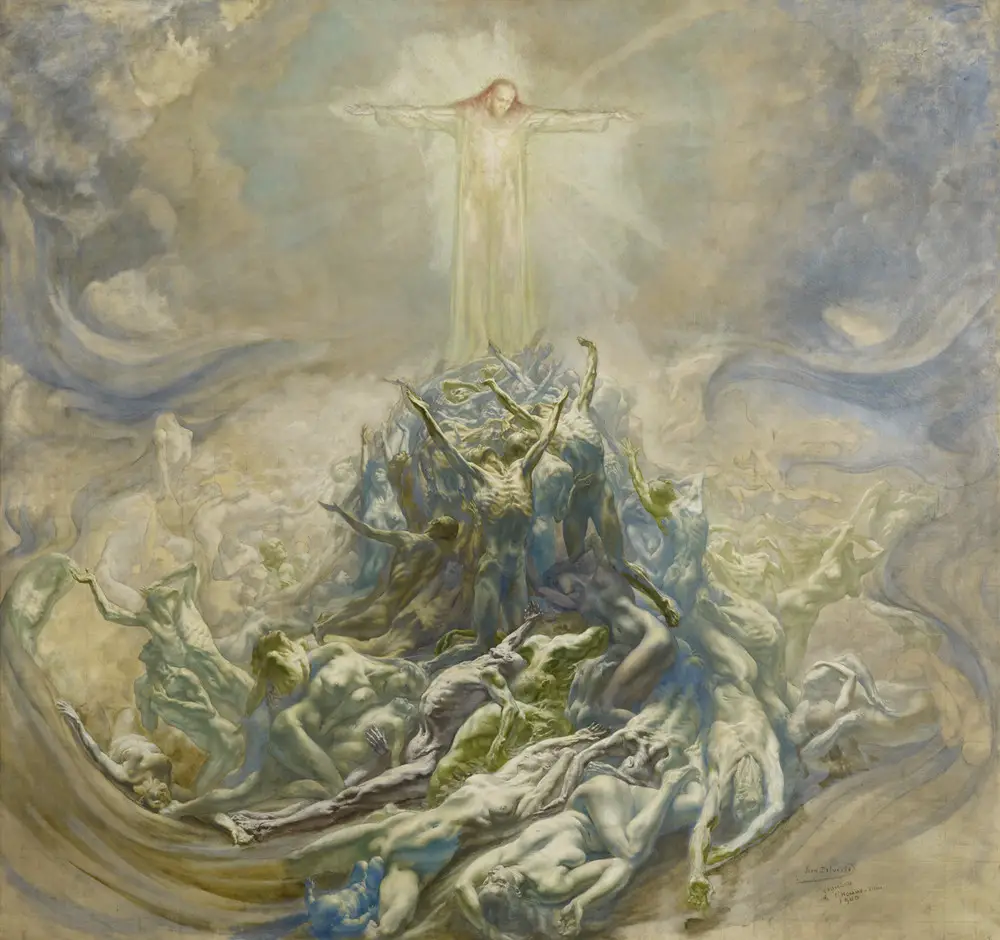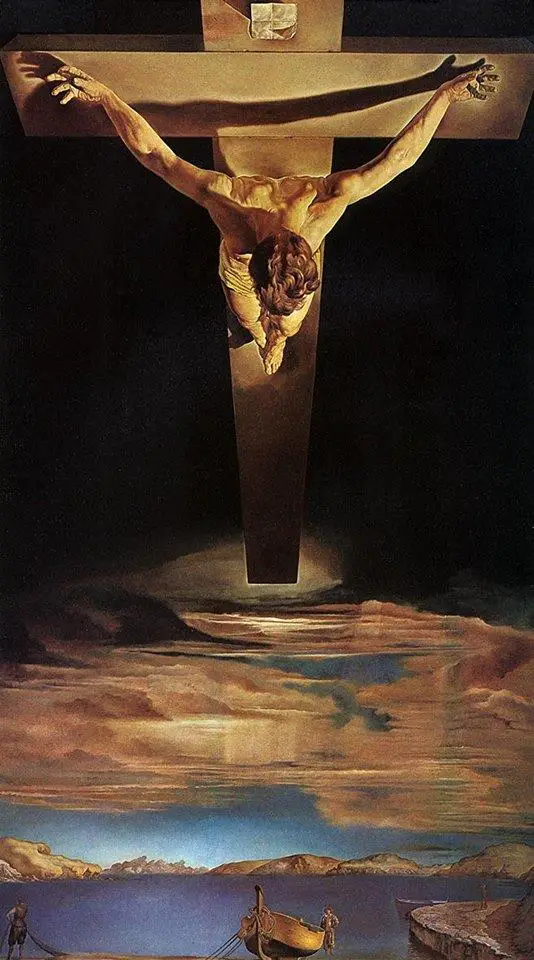The lighting of the fire, the texts that trace the sacred history, the rite of water that evokes the mystery of death-and-resurrection of baptism. The Sacred Meal of the Body and Blood of Christ: "the greatest hierophany" according to Mircea Eliade. The liturgy of the Easter vigil transmits a mysterious and initiatory meaning over the centuries.
di "Gothic"
cover: Matthias Grunewald, "Resurrection of Christ"
Despite the ideologization of the Church and its confluence in decadent ideology, and despite the loss of the most organic form in Latin, the celebration of the night of Holy Saturday - the culmination of the Catholic liturgical year - still expresses the essence of a mystery: a properly initiatory mystery. In its present form, the celebration of Easter night highlights a scan that evokes the four elements, in succession: Fire, Air, Water, Earth.
It begins with a suggestive one ignition of the Fire, with forms that echo the ancient Zoroastrian cults. The flame that is released from the wood is used to light the candle that symbolizes Christ, and in fact five grains of incense are planted on it to symbolize the four stigmata and the wound in the side, from which water and blood flowed. The current year from the birth of Christ is marked on the candle and the Greek letters Alpha and Omega to remember the saying of the Apocalypse "I am the Alpha and the Omega".
The lit candle is the Light that shines in the darkness, which conquers the darkness of death. This Light is carried in procession along the dark central nave of the church. The priest advances, the altar servers and the people follow with lighted candles in their hands. It is a procession of income that evokes a truly mysterious atmosphere. During the procession the celebrant invokes the Light of Christ: Lumen Christi! The people respond Deo gratias. At the third invocation the lights of the Church are turned on. From this moment on, the whole celebration is marked by joy, exultation for the triumph of life over death, of light over darkness.
We now move on to the second phase: the rituals of fire and light are followed by the liturgy of the word, the readings give voice, breath to the narration of the sacred history of the world, for this reason we believe that at this point we pass under the "domain of Air". The readings can go up to the symbolic number of seven. The first is that taken from Genesis which describes the Creation, the intelligent divine plan that gives impetus to the evolution of the phases of the Earth with the progressive appearance of the star and planetary forms, of the elements of the earth, of the kingdoms of nature up to the culminating figure of the Man: not an outcast being but lord and guardian of creation.
The second reading evokes the figure and the act of faith of the patriarch Abraham, his entrusting himself to God. Abraham kneels to a mysterious and superior figure, a sort of Sacral King: Melchidesech. While Abraham makes the "lunar" sacrifice of the lamb, the King of Salem who unifies royalty and priesthood makes the "solar" offering of bread and wine. It is the same offering that returns with the Eucharistic supper and the consecration of the bread and wine as the body and blood of God made Man.
In the third reading the memory of the passage between the waters flows as a symbol of victory over slavery (in the context of the Exodus, from Egypt) and of liberation. In the Bible the theme of the waters as death and resurrection returns three times: first. in the story of the flood with Noah generating a new humanity, a story that resembles with significant analogy a story referring to the Manu in the sacred Hindu writings. Secondly in the story of the escape between the waters of the red sea and finally in the description of baptism: an authentic initiation rite of death-and-resurrection with immersion in the running water of the river.
The Fourth and Fifth Readings are taken from the writings of Isaia, the prophet who announces the birth of the child Savior, with tones that closely recall the IV Ecloga in which Virgil announces the birth of Boy. The sixth and seventh readings are also taken from the Prophets, Baruch and Ezekiel; the latter is the prophet who refers to the resurrection of the flesh, therefore to that mystery which in other traditions takes the form of doctrine of the body of glory, of the body of diamond-thunderbolt. The cycle of readings therefore ends with the splendid canticle of the new heart:
«I will give you a new heart, I will put a new spirit within you, I will take the heart of stone from you and I will give you a heart of flesh. I will put my spirit within you and I will make you live according to my statutes and I will make you observe and put my laws into practice. You will live in the land that I gave to your fathers; you will be my people and I will be your God. I will free you from all your impurities: I will call the grain and multiply it and I will no longer send you famine. "

At this point the song of Gloria rises. even the Glory in Excelsis, as well as the ignition of the Fire, evokes Zoroastrian reminiscences. The Glory aspect of the Supreme Lord is proclaimed, as the Angels proclaimed it at the time of the Savior's birth, when light was made as of the Sun at Midnight. Glory shines in the sublime heights of the heavens and is reflected in the earth as Pax, peace for men of good will: an expression that recalls the Pax Imperialis Roman (and in fact the birth of Christ is, with clear liturgical expression, connected to the epoch of great peace inaugurated by Augustus).
It is up to men to adore, praise, bless this Divine Glory, drawing the highest benefit from it: the purification of sins, or the liberation from human imperfections that result from the loss of the Edenic condition, of the beatitude of the golden age. The highest expression of the Glory of God the Father is the Resurrection of his Son. And this is what is now being announced. The reading of St. Paul's Epistle to the Romans now clarifies how all the faithful through the initiatory rite of Baptism can participate, identify themselves with this mystery of divine death-and-resurrection.
The liturgy of the word culminates in the reading of the Gospel: the story of the apparition of angels to women at dawn on resurrection Sunday. Women at the time did not have testimonial capacity (as still today in the Islamic area they have half the testimony capacity): whoever wanted to invent a story to attest to a non-existent resurrection would never have involved the testimony of a woman, because this would have meant disqualifying from the start. the narrative that it was intended to validate. This is one of the many details that suggest that the Gospel text follows the thread of devout spontaneity more than that of a cunning artificiality.
After the priest's homily on the Sacred Word, the liturgy becomes denser. We now enter the "Water domain". If there are infants they are baptized, if there are not the entire people of the faithful, they consciously relive the experience of baptism and repeat the act of belief in the Divine Trinity and the solemn renunciation of compromise with the satanic element, that is, with forces hindering. In this circumstance the candle that evokes the interior Light, small but consubstantial with the Light of Christ, is rekindled.
With the Paschal Candle for partial immersion the basins of Water are blessed. Lapped by the source of Light, the water becomes holy, blessed water, the bearer of etheric-vital forces. The priest sprinkles the people: the water that bathes the faces and bodies of those present transmits the freshness of the regeneration of the etheric forces, just as the liturgy of the word had revived the interior and the Fire lit at the beginning of the celebration had lit the light of 'I AM ("I am who I am," Christ says of himself).
At this point we move on to the Eucharistic consecration, that is to the transubstantiation of matter which becomes a receptacle for the body and blood of God made man. The "fruits of the earth and of man's work" are presented to God the Father and become the Body and Blood of Christ. To prepare for this radical sacralization of matter, the Priest performs a solemn gesture: incenses the altar. But that altar is actually a sacrificial tomb, the linen that covers it symbolizes the Holy Shroud that enveloped Christ before the radiation of the Resurrection.
Incense in ancient times went up to the Gods. Now the Priest, after having incensed the altar and the cross, is in turn incensed and also the public of the faithful - made partakers of the same dignity - is incensed. The words of the consecration repeat the phrases of the Last Supper in the Gospel story, they join the invocations to the ranks of angels, of the saints as a protector army deployed in defense of men. The dead are also remembered.

In this way what Eliade defined as "the supreme hierophany" takes place: the bread and the wine that become the body and the blood. The Host (from visitors: to be sacrificed) is offered to the faithful who become diners. The most archaic rite, that of the sacred meal, dating back to the mists of time, when the members of the archaic warrior brotherhoods divided the hunted prey among themselves according to the hierarchical order and with the Gods who had propitiated the hunt, is renewed this time in a bloodless, since Christianity overcomes animal sacrifices (while the regressive form of Islam restores them).
With the Eucharist the passage through the elements becomes complete:
- Fire of the lighting of the lamp symbolizing Christ.
- Air of the Liturgy of the Word.
- Water of the renewal of baptism and sprinkling of the faithful.
- Earth with the radical sacralization of the matter of bread and wine.
These four phases ritually correspond to the modern initiatory experience (according to the lesson of Steiner) of the development of the ego that connects consciously to the Divine, of the Astral Body becoming Spiritual Self-my, the Etheric-Vital Body which becomes Vital Spirit-Buddhism and Physical Body that becomes Spirit Man-Atma or Body of Glory. The celebration ends with the Blessing. The priest transmits the Blessing, or the promise of benevolence and divine protection in existence, both in its spiritual and material aspects. With this Blessing the rite is completed.
Now the way of our times excludes ritualistic forms. Attempts to recall ancient rituals to life are completely sterile and the Catholic liturgy itself is no longer able to transmit living forces. But surely the Exercise of Positivity on these mystery forms transmitted over the centuries and partially decayed is a possible and certainly profitable exercise.

5 comments on “The rites of Easter night as an initiatory mystery"